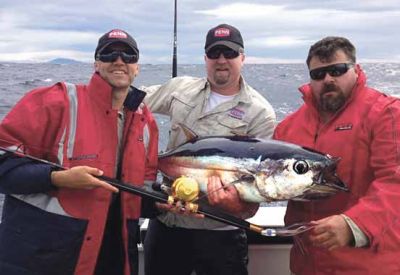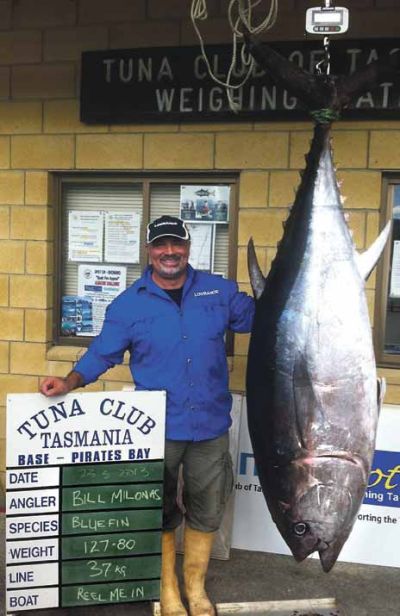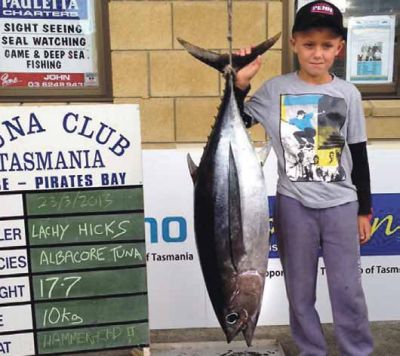 Presented from Issue 103, April 2013
Presented from Issue 103, April 2013
The 2013 Tuna season has opened with a tremendous head of steam. The west coast was treated to spectacular a sighting of Bluefin Tuna smashing bait from Macquarie Harbour all the way to Point Hibbs. These fish have fed well and are turning up in good numbers and good size. In this month’s issue we look at a few hints and tips that should have a few of those 30 plus kilo Bluefin with one of your lures in its mouth. The rest is up to you and your crew.
Team PENN – DOUBLE BLACK has started the year well and loves fishing off the East and South coasts of Tasmania for Tuna. We have many years’ experience on board and would love to share some advice that may have you catch a few as well.
Hints and tips
Rigging: Two types of rigging for Tuna and it really comes down to if you are intending to competition fish or recreational fish. The competition rules of a sanctioned competition demand that all rigs and leader lengths conform to an IGFA standard. This at first can sound horribly confusing but with a little reading it is quite simple to nut out. The details of such are probably better devoted to a story in itself, so I will just discuss recreational rigging.
Hook placement and the manner in which you rig to place your hook is the debated question here. There are a number of simple ways to rig and crimp the business end of a Tuna lure and they can be found on the internet and YouTube. Pick one that suits your style of fishing and the fish you wish to target, practice this and you can’t go wrong.
Hard bodies have found favour with anglers looking for fish on bright or quiet days and there has been a trend to change out big trebles for singles. There is an argument for better hook up rates. The jury is out on this one, but my opinion is there is better holding power on a good size single and easier release once boated.
 Lure styles, colours and sizes.
Lure styles, colours and sizes.
Traditional skirted pushers have been the favour of most anglers for a very long time when targeting Tuna. More and more we are starting to see “sub” surface lures like MAC baits and big bibbed divers. These lures are fantastic options when it is bright out or the fish have shut down a touch.
The extra action these lures generate can raise a strike out of a fish purely for that agonising wounded bait fish waddle. Their other advantage of course is they offer another dimension to the spread by being down deeper into the food bowl.
Colours for these lures start out with “matching the bait” Work out what your target fish are feeding on, the size they are on and you won’t go far wrong. OK smarty pants explain Pink Mac baits You have me there. Pink Mac baits have been a fantastic lure for tuna and the explanation on why is a fun topic. It can be argued it’s the “action” or it may be we started to have success so they are always the one out, so it “just seems’ to me like the GO TO for any occasion.
The fishing for large tuna down south has had great success with Halco’s King Brown and other patterns. These lures trolled slowly reach fantastic depth and can find a hungry fish down deep.
Skirted surface lures are the big player in the art of catching tuna. There are a number of good quality brands that work very well. Here is the point that I like to make. They do have to “work” By work I mean breath, pull down a smoke trail and re-surface.
There are a number of different head shapes that dictate when and at what interval they will do this at any given spread position.
The general rule of thumb is the longer the head the further back in the spread that lure should run. The shorter lures with a cupped face when working well should cup a bit of water forwards when they take a breath. All these factors will have your spread doing what it is intended to do and that is look like a nervous bait school.
Tasmanian conditions demand that you have a couple of lures from the Zacatak lure range. Mario builds a quality Australian made lure and has a massive range of skirt combinations that mimic our unique Tasmanian bait - Redbait.
Lure skirt combinations that mimic squid are also a good choice and a good starting point to any spread. Weather can be a big decider on what type of lures to run. If the conditions are a bit sloppy and windy it may pay to slow a touch and run some big divers along with a couple of Jet Heads.
Trolling speed and lure spreads
The best albacore tuna trolling speeds are within a range of six and eight knots. Switching to larger lures can draw interest from yellowfin and bluefin tuna, but the trolling speed is still about the same. If you have surface skirts out keep an eye out on how they are behaving. If they are spending more time out of the water than under the surface it may be time to slow down a touch. Traveling up wind and either with or against a swell and current will also affect your speed.
Keep a close eye on your spread and adjust speed accordingly when you turn and run with the sea again. When trying to find fish you can run as many rods as you can manage and try and work straight lines. Once you find fish and mark them with a waypoint on the GPS, pull the spread back to 4 allowing you better ability to wheel around and pick up some more without any issues.
Attractors or not I am a big fan of having some sort of “Teaser” running at the rear of the boat. They can take many forms and come in a number of styles, but something at the back of the boat creating a splash and or a flash like a school of bait fish cannot be a bad thing. The wash of the boat is already creating froth and bubble that fish will come to investigate. The added shape and flash of a teaser will keep them interested until they spot your lures.
 Water temperature to look for, temperature breaks
Water temperature to look for, temperature breaks
Water temp will vary depending on what species of tuna you are targeting. Traditionally albacore will be found in the warmer water to 17 + degrees. Bluefin is a fish more suited to the cooler water temps below 18 degrees. Yellowfin are trickier again. They like to feed in the cooler water but habitat the warmer currents when not feeding. Look for the sea surface charts to give you an indication on local water temps
Water depth
The decision on what depth to fish for tuna can also be attributed to another factor — bait Large concentrations of bait can be found on the continental shelf and working the areas across the considerable depth variations can work well. It can be very easy to get hung up on a lot of tips and age old ideas on when and where to catch tuna. Water depth is a classic example.
Most definitely there are areas that hold fish and are great places to start, but fish do two things. SWIM and EAT they have tails and must at times be in transit for their next meal. If next time you are setting off for a known tuna holding area and the weather doesn’t allow you to get there quickly, put the lures out and troll there. You may be surprised
What I am trying to say is if you don’t have a boat big enough to chase tuna on the shelf or off the back of Tasman Island come out of the shelter of Fortescue Bay and sneak about — weather depending. St Helens in and around Merricks is another area that can hold tuna and not be an issue to a smaller vessel
Birds - what do they mean?
If you are a fisherman you love birds! You might not be that happy with the big Albatross that picks your shotgun lure out of the spread, but any other bird is the fisherman’s friend. When trolling around scanning the horizon for birds, there is nothing as exciting as watching a group of gannets gaining height and then start to dive bomb the surface. This means they have found some bait that is on the surface. More often than not bait are on the surface because something considerably bigger than them is feeding on them. The birds can see this commotion and think “free feed”
Everyone loves a free feed and the birds of the southern ocean are no exception. This concentrated bird activity is a key indicator of TUNA. If it is happening some distance away, pull the lures in and motor over. Once within a couple of hundred meters calmly re set your spread and work the edges of the “FEED”. The worst thing you can do is motor right through them.
Moon
Does it matter, time of day, wind direction, cloud or not
To me all this does matter. However it is an article all in itself. What I would like to share is most of us have little opportunity to go fishing at the drop of a hat and to try and target fish feeding trigger points. I would suggest that when you go fishing keep a log book. Write down the weather and conditions. Put pen to paper when you caught a fish and log time and conditions. Keep it short and very specific. After a short while you will have some decent information that will suggest to you the better times to go out and raise the percentage of being successful. Then it can be used to plan future trips and better outcomes. It’s great to just fish with mates and be out in the elements, but coming home with a nice amount of freezer fodder keeps the cook happy
 Outfits - Overhead or egg beaters
Outfits - Overhead or egg beaters
This question really depends on personal choice and the probability of entering any fishing competitions. The overhead reels are excellent for line holding capacity and ease of setting breaking strain parameters. The lever drag systems can be pre-set checked and you have the confidence that where you set the lever is the pre-determined drag tension. Overheads also have the added ability to attach a fighting harness should you come along that fish of a lifetime.
Egg beaters or spinning reels are coming into favour and for good reason. The bigger jobbies in the 8500 series and above have enough line capacity and drag pressure to hold most Tuna an angler will encounter. It takes a bit of getting used to setting strike drag and ramping them up to fight tension, but it all comes from a little practice and you are good to go.
Caring for your catch
Tuna destined for the table should be bleed immediately after capture. Knifing in behind the pectoral fin 90 degree’s to the lateral line will allow this to be achieved. Getting the fish on ice is important in keeping the flesh in best condition. If not in a competition it is often best once the fish has been bled and rested to take off the edible flesh as soon as you can. This allows the fillets to be iced down in eskies a lot easier than whole fish. It also solves the issue of cleaning back at the ramp and looking for somewhere to dispose of the frames in a responsible manner.
Safety
The technology we all have at arm’s length is amazing and there is no excuse for not being able to access an up to date weather forecast. When venturing offshore to target Tuna it is very important to have an understanding of the forecast wind, and what effect that will have on sea conditions. Depending on direction and strength, a nice looking morning on the water can turn very uncomfortable later in the day. In Tuna fishing you cover a lot of ground and can be quite some way from the boat ramp. Coming back home into nasty weather that is only getting worse IS NOT GOOD!
The sometimes long hours between strikes can be a great time to show those on board where the safety gear is located and how to use it for those new to the sport. I like to have a bit of a “Half Time” tidy up as the day goes on as well. If you have been lucky enough to have hooked and caught a few that can leave the deck in a bit of disarray and with lure leaders,
Teaser ropes and spare rods and Gaffs about it can get a bit hectic. Lunch is a good time to get everything back nicely stowed and reset for some more action. Not a lot worse than to lose a fish of a life time due to tripping over something or failing to get the rod out and around the back of the motor because you got caught up on the squid rod you had in the way.
So there you go. A few tips and ideas that we hope will have you find some fish and get them to the table in good condition.
Kelly Hunt




